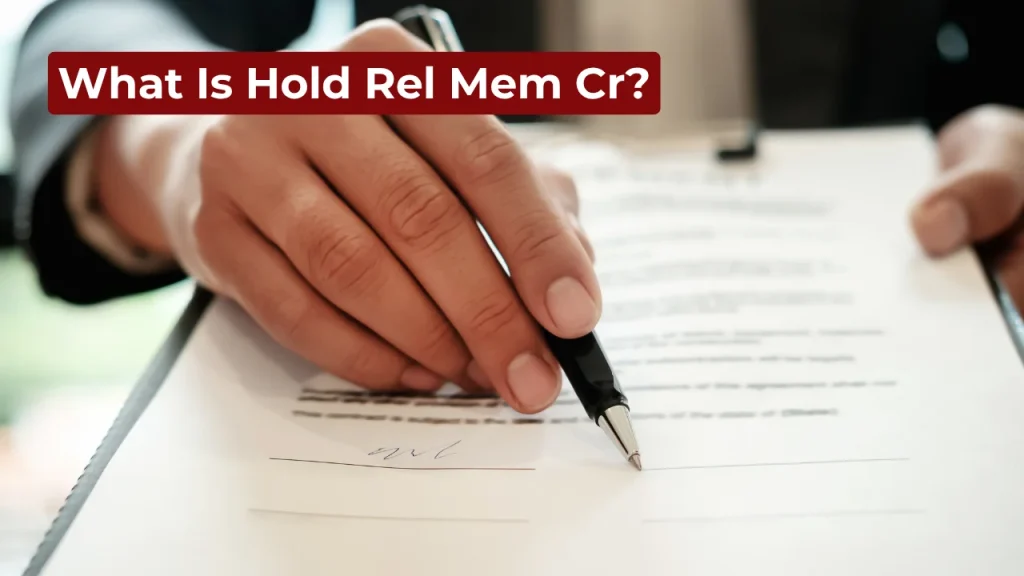Have you ever glanced at your bank statement and spotted a cryptic code like hold rel mem cr? It’s confusing, right? You’re not alone. Many people see this term, especially with Chase Bank, and wonder what it means, why their money is on hold, and how to fix it. This article is your guide to unraveling the mystery of hold rel mem cr, explaining why it happens, what you can do about it, and how to avoid stress next time it pops up. With real-world insights and practical tips, I’ll walk you through everything you need to know to feel confident about your bank account.
Let’s dive in and clear up the confusion so you can manage your finances like a pro.
What Is Hold Rel Mem Cr?

You’re checking your Chase account, and there it is: hold rel mem cr. It sounds like a secret code, but it’s not as complicated as it seems. This term, short for “hold relinquished member credit,” is a bank notation that indicates a temporary hold or delay on a deposit. It usually shows up when you deposit a check, and the bank needs time to verify the funds before making them fully available.
Breaking Down the Term
The phrase hold rel mem cr can be split into parts. “Hold” means the bank is restricting access to some or all of the deposited funds. “Rel” stands for relinquished, meaning the hold has been or will soon be lifted. “Mem cr” refers to member credit, which is the bank’s way of noting the deposit as a credit to your account. Together, it signals a temporary delay in funds availability.
Why It Appears on Statements
Banks like Chase use codes like hold rel mem cr to track internal processes. When you deposit a check, the bank may place a hold to ensure the check clears and the funds are legitimate. This is standard practice, especially for large deposits or checks from unfamiliar sources.
Common Scenarios for Holds
You might see hold rel mem cr after depositing a large check, such as a tax refund, a paycheck, or a payment from a new client. It can also appear if the check is from an out-of-state bank or if your account has had recent issues, like overdrafts.
Real-Life Example
In my experience, I once deposited a $5,000 check from a freelance gig, only to see hold rel mem cr on my Chase statement. The funds showed as “pending” for three days. It was frustrating, but a quick call to the bank clarified that the hold was due to the check’s size. Knowing why it happened eased my worry.
Why Did Chase Put My Deposit on Hold?
Chase, like other banks, places holds on deposits for several reasons. Understanding these can help you anticipate and manage holds effectively. Let’s explore the most common triggers.
Large Deposit Amounts
Banks often flag deposits above a certain threshold, typically $5,000, for extra scrutiny. This is to protect against fraud or bounced checks. If you deposit a hefty sum, expect a hold rel mem cr pending status until the bank verifies the funds.
New or Unusual Activity
If you rarely deposit checks or suddenly deposit one from a new source, Chase may hold the funds to ensure everything checks out. For example, a check from an unfamiliar payer or an out-of-state bank might trigger this.
Account History Issues
A history of overdrafts, bounced checks, or low balances can make banks cautious. If your account has red flags, Chase might place a temporary hold on funds to minimize risk.
Bank Policies and Regulations
Federal regulations, like the Expedited Funds Availability Act, allow banks to hold deposits for a set period, typically 2-7 business days. Chase’s policies align with these rules, but they may extend holds for specific cases, like international checks.
Table: Common Reasons for Deposit Holds
| Reason | Description | Typical Hold Duration |
| Large Deposits | Checks over $5,000 are flagged for verification. | 2-7 business days |
| New Payer | Checks from unfamiliar sources may raise fraud concerns. | 3-5 business days |
| Account Issues | Overdrafts or low balances increase scrutiny. | 1-5 business days |
| Out-of-State Checks | Non-local checks take longer to clear. | 5-7 business days |
| Regulatory Compliance | Banks follow federal rules to prevent fraud. | Up to 7 business days |
How Do I Get a Hold Removed from a Deposit?
Seeing your money tied up in a hold rel mem cr can be a headache, especially if you need it fast. Here are steps to speed up the process and regain access to your funds.
Contact Your Bank Immediately
Call Chase’s customer service at (800) 935-9935 or visit a branch. Explain the situation and ask about the hold’s status. Be ready with your account details and the deposit amount.
Provide Supporting Documentation
If the hold is due to a large or suspicious check, provide proof, like an invoice or contract, to verify the funds. This can convince the bank to release the hold sooner.
Check Your Bank’s Policies
Review Chase’s funds availability policy online or in your account agreement. Knowing their rules helps you make a stronger case for releasing the hold.
Request an Exception
If you need the funds urgently, politely ask for an early release. Banks sometimes make exceptions for loyal customers or emergencies.
Here’s a Tip I Always Give Beginners
Always deposit checks early in the week. Banks process deposits faster on weekdays, and holds placed on Friday might stretch over the weekend, delaying access.
What Are the Consequences of a Hold?
A hold rel mem cr isn’t just an inconvenience—it can affect your financial plans. Let’s break down what happens when your funds are on hold and how to manage it.
Limited Access to Funds
The most immediate impact is restricted access to the deposited amount. You can’t use the money for withdrawals, payments, or transfers until the hold lifts.
Small Transactions Allowed
Chase often allows access to a portion of the deposit, like $200-$500, for smaller transactions. Check your available balance to see what’s usable.
Potential for Overdrafts
If you spend assuming the full deposit is available, you might overdraw your account, leading to fees. Always confirm your available balance before making big purchases.
Delayed Financial Plans
A hold can delay bill payments, investments, or other plans. For example, if you’re waiting on a $2,000 check to pay rent, a hold could force you to juggle funds.
Table: Impact of Holds on Your Finances
| Consequence | Details | How to Mitigate |
| Limited Fund Access | Can’t use held funds for transactions. | Check available balance regularly. |
| Partial Fund Availability | Small amounts (e.g., $200) may be usable. | Confirm with bank before spending. |
| Overdraft Risk | Spending unavailable funds can incur fees. | Monitor account activity closely. |
| Delayed Plans | Held funds can disrupt payments or goals. | Plan deposits with buffer time. |
How to Avoid Holds in the Future
Preventing a hold rel mem cr can save you time and stress. Here are five actionable strategies to keep your deposits flowing smoothly.
Five Actionable Tips to Avoid Deposit Holds
- Deposit Early in the Week: Banks process checks faster on weekdays, reducing hold times. Avoid depositing on Fridays or holidays.
- Use Direct Deposits: Electronic transfers, like paychecks, clear faster than paper checks, often avoiding holds altogether.
- Build a Strong Account History: Maintain a positive balance and avoid overdrafts to gain trust with your bank.
- Verify Check Sources: Deposit checks from well-known payers, like employers or government agencies, to reduce scrutiny.
- Communicate with Your Bank: Notify Chase about large or unusual deposits in advance to streamline processing.
What I Learned the Hard Way Is…
I once deposited a check right before a holiday weekend, thinking it would clear quickly. Big mistake! The hold rel mem cr lasted five days because banks were closed. Now, I always deposit early in the week to avoid delays.
Why Is There Money on Hold in My Bank Account?
Holds aren’t random—they’re part of how banks manage risk. Let’s dig deeper into why your money might be stuck and what it means for you.
Fraud Prevention Measures
Banks use holds to protect against fraudulent checks. If a check bounces after you spend the funds, the bank is liable. A hold rel mem cr ensures the funds are legitimate.
Bank Processing Times
Checks, especially from other banks, take time to clear. Out-of-state or international checks can take up to 7 days, triggering a hold until verification.
Regulatory Requirements
Federal law allows banks to hold deposits to comply with anti-money laundering rules. Large or suspicious deposits often face longer holds to meet these standards.
Account-Specific Factors
Your account’s status matters. New accounts, frequent overdrafts, or low balances can lead to stricter hold policies, as banks see these as higher-risk.
Common Myths About Hold Rel Mem Cr
There’s a lot of confusion about hold rel mem cr, especially on forums like Reddit. Let’s debunk some myths to set the record straight.
Myth: Holds Mean Your Check Is Bad
A hold doesn’t mean the check is invalid. It’s often just a precaution to ensure the funds clear properly.
Myth: All Holds Last a Week
Hold durations vary. Small checks might clear in 1-2 days, while large or out-of-state checks could take longer.
Myth: You Can’t Access Any Funds
Even with a hold rel mem cr, Chase often releases a portion of the deposit, like $200, for immediate use.
Myth: Holds Are Permanent
Holds are temporary. Once the bank verifies the deposit, the funds are fully available.
Table: Myths vs. Facts About Holds
| Myth | Fact |
| Holds mean the check is bad | Holds are precautionary, not a sign of an invalid check. |
| All holds last 7 days | Durations vary from 1-7 days based on check type and amount. |
| No funds are accessible | Partial funds (e.g., $200) are often available during the hold. |
| Holds are permanent | Holds are temporary and lift once the deposit clears. |
FAQs About Hold Rel Mem Cr
What does hold rel mem cr mean?
It’s a Chase Bank code for a temporary hold on a deposited check, meaning the funds are pending verification before being fully available.
How long does a hold rel mem cr last?
Holds typically last 1-7 business days, depending on the check’s size, source, and your account history.
Why did Chase put my deposit on hold?
Chase may hold deposits to prevent fraud, verify large amounts, or comply with federal regulations, especially for new or unusual checks.
How can I get a hold removed from a deposit?
Contact Chase, provide documentation, and request an early release. Visiting a branch or calling customer service can speed things up.
Can I still use some funds during a hold?
Yes, Chase often releases a small portion, like $200-$500, for immediate use, depending on the deposit and account status.
What if I need the funds urgently?
Call Chase or visit a branch to explain your situation. They may release the hold early for emergencies or loyal customers.
Also Read: Coomersu: Your Guide to the Future of Online Shopping
Conclusion
Seeing hold rel mem cr on your Chase statement can feel like a roadblock, but it’s just a temporary hiccup. It’s the bank’s way of ensuring your deposit is safe and legitimate. By understanding why holds happen—whether due to large deposits, new payers, or bank policies—you can take steps to manage or avoid them. Contact Chase, provide documentation, and follow our actionable tips, like depositing early in the week or using direct deposits. With this knowledge, you’re better equipped to handle your finances confidently and keep your money moving smoothly.

